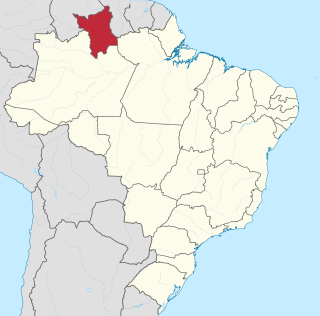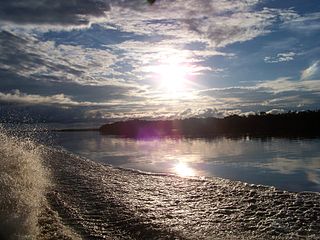
Amazonas is a state of Brazil, located in the North Region in the north-western corner of the country. It is the largest Brazilian state by area and the ninth-largest country subdivision in the world. It is the largest country subdivision in South America, being greater than the areas of Chile, Paraguay, and Uruguay combined. Mostly located in the Southern Hemisphere, Amazonas is the third-largest country subdivision in the Southern Hemisphere after the Australian states of Western Australia and Queensland. Located entirely in the Western Hemisphere, it is the fourth-largest country subdivision in the Western Hemisphere after Greenland, Nunavut, and Alaska. If independent, Amazonas could become the sixteenth-largest country in the world, slightly larger than Mongolia. Neighbouring states are Roraima, Pará, Mato Grosso, Rondônia, and Acre. It also borders the nations of Peru, Colombia and Venezuela. This includes the Departments of Amazonas, Vaupés and Guainía in Colombia, as well as the Amazonas state in Venezuela, and the Loreto Region in Peru.

Roraima is one of the 26 states of Brazil. Located in the country's North Region, it is the northernmost and most geographically and logistically isolated state in Brazil. It is bordered by the state of Pará to the southeast, Amazonas to the south and west, Venezuela to the north and northwest, and Guyana to the east.

Amazônia Legal, also known as Brazil's Legal Amazon (BLA), is the largest socio-geographic division in Brazil, containing all nine states in the Amazon basin. The government designated this region in 1948 based on its studies on how to plan the economic and social development of the Amazon region.

Rorainópolis is a municipality located in the southernmost point of the state of Roraima in Brazil. Its population is 30,782 and its area is 33,594 km2. The municipality is crossed by the equator.

The Balbina Dam is a hydroelectric dam and power station on the Uatumã River in the Amazon Rainforest, Brazil. The location is under the municipality of Presidente Figueiredo jurisdiction, in the state of Amazonas.

Novo Airão is a municipality located in the state of Amazonas in northern Brazil on the Rio Negro River about 180 km upstream of Manaus. Its population was 19,928 (2020) and its area is 37,771 km2. The town is accessible by both river and road.
Alalaú River is a river forming part of the border between the Amazonas and Roraima states in north-western Brazil, a tributary of the Jauaperi River.
Camanaú River is a river of Amazonas state in north-western Brazil, a tributary of the Curiuaú River.
The Jauaperi River is a river of Amazonas state in northwestern Brazil, a tributary of the Rio Negro.
The Pitinga River is a river of Amazonas state in north-western Brazil. It empties into the Balbina Dam on the Uatumã River.

BR-174 is a federal highway of Brazil. The 3,321 km (2,064 mi) road connects Cáceres to Pacaraima on the Venezuelan border. It is the only road connection of the state of Roraima with the rest of the country. 458 kilometres are under construction, and there is no bridge over the Amazon River.
The Waimiri Atroari language is spoken by the Waimiri Atroari people. The current population is 2,009, and they have 19 villages spread along the rivers of Camanau/Curiau, Alalaii, Jauaperi, and Rio Branquinho. These are located in the northern part of the State of Amazonas, and the southern part of the State of Roraima. The people call themselves Kinja and call their language Kinja Iara. The language has many other names such as, Atroahy, Atroahí, Atroarí, Atroaí, Atrowari, Atruahi, Atruahí, Ki'nya, Krishaná, Waimirí, Waimirí-atroarí, Yawaperí (Glottolog). This language seems to have a high transmission as it is spoken by all members of the community and is the main language used for reading and writing.
The Roraima National Forest is a national forest in the state of Roraima, Brazil.

The Serra do Aracá State Park is a state park in the state of Amazonas, Brazil.

The Tucuruí transmission line is a hydroelectric power line that leads north from the Tucuruí Dam in Pará, Brazil and crosses the Amazon River. From there the eastern branch leads to Macapá in Amapá and the western branch leads to Manaus in Amazonas. The towers supporting the span across the Amazon River are nearly as high as the Eiffel Tower. Work to extend the line from Manaus north to Boa Vista, Roraima, is due to complete in 2018. There were delays in issuing the environmental permits and then legal challenges since the line crosses the territory of indigenous people who had not been consulted. Although efforts have been made to avoid environmental damage, there has been controversy about the impact of construction and of the tower maintenance corridor.

The Waimiri Atroari Indigenous Territory is an indigenous territory in the states of Amazonas and Roraima, Brazil. There has been a long history of violent conflict between the indigenous Waimiri-Atroari people and newcomers from other parts of Brazil. Since the 1960s there have been many efforts to "civilise" the Waimiri-Atroari to avoid problems with the BR-174 highway, which cuts across the territory, and with tin mines and the huge Balbina Dam. The territory is now considerably smaller, but there have been improvements in living standards.

The Pitinga mine is an open pit tin mine in Brazil. It is thought to have the largest undeveloped tin deposit in the world. A complete community of 5,000 people was established in the remote location in the Amazon rainforest to support the mining operations, which began in 1982. There have been accidents, but efforts have been made to minimise environmental damage and to restore areas that have been mined. As of 2014 the more accessible alluvial deposits had been exhausted, but mining of primary rock was continuing.

The Lower Rio Negro Mosaic (Portuguese: Mosaico do Baixo Rio Negro is a protected area mosaic in the state of Amazonas, Brazil. It coordinates between eleven conservation units of different types in the Amazon rainforest to the northwest of the state capital, Manaus.

The Yanomami Indigenous Territory is an indigenous territory in the states of Amazonas and Roraima, Brazil. It overlaps with several federal or state conservation units. It is home to Yanomami and Ye'kuana people. There are ongoing conflicts with an overlapping national forest in which mining was permitted.












